Atlanta’s Cultural Evolution: From Freaknik to the Beltline – Understanding 35 Years of Transformation

How Old Alanta Became New Atlanta
Introduction: The Tale of Two Atlantas
Atlanta, Georgia, is a city of contrasts and continuous reinvention. For those who knew the city in the 1990s, today’s Atlanta might seem like an entirely different metropolis. The skyline has changed, neighborhoods have transformed, cultural epicenters have shifted, and even the population itself has evolved dramatically.
This transformation didn’t happen overnight. It represents decades of economic shifts, policy decisions, cultural movements, and demographic changes that collectively rewrote the story of Georgia’s capital city. Understanding this evolution provides insights not just into Atlanta’s journey, but the broader American urban experience.
What You’ll Discover: In this 6-part series, we trace Atlanta’s remarkable 30-year transformation, exploring how a city rooted in civil rights history and Southern tradition evolved into a global entertainment hub and economic powerhouse. We also navigate complex issues of gentrification, cultural preservation, and urban renewal.
Whether you’ve experienced “Old Atlanta” firsthand or are a newcomer curious about the city’s roots, this guide offers a comprehensive look at the forces that shaped the ATL we know today. Through examining key cultural institutions, economic developments, political milestones, and social movements, we’ll uncover how Atlanta’s past continues to influence its present and future.
Part 1… Historical Overview: Old Atlanta in the 1990s
Atlanta in the early 1990s was a city finding its footing after decades of civil rights struggles and white flight to the suburbs. It was a predominantly Black metropolis with distinct cultural zones and socioeconomic divisions.
The Cultural Landscape
Old Atlanta was characterized by vibrant cultural spaces which served as community anchors for Black Atlantans. In the 90s Greenbriar and South DeKalb Malls not only served as shopping destinations for locals, but also as social gathering spots for young Black teens. Greenbriar Mall location is within the city limits of southwest Atlanta, and South DeKalb Mall is located in the eastern metropolitan community of DeKalb County. In 1989, an emerging social and shopping center reemerged, known as Underground Atlanta.
In 1980, Underground Atlanta closed as a downtown entertainment district due to its decline in interest and growing crime problems in the area. Reopened in 1989 with new life as a shopping district because Underground Atlanta became a central location for people to shop and hang out at. Not long after in 1990, the original World of Coca-Cola opened right next door to Underground Atlanta. The World of Coca-Cola was an attraction dedicated to the history of the popular Atlanta-based soft drink, Coke.
Have you ever seen the movie, “A.T.L.” with Atlanta-based rapper, T.I.? The popular old skating rink, Jelly Beans, was the inspiration behind the film produced by Atlanta’s own super producer, Dallas Austin, and T-Boz, of RnB trio, TLC. Jelly Beans was a location in southwest Atlanta that was the go-to spot for fun in Atlanta.
The Atlanta University Center, comprising historically Black colleges and universities, anchors academic and cultural life: Clark Atlanta University, Morris Brown College, Spelman College and Morehouse College. These academic institutions were the educational foundations of not only the 90s students who attended them, but also Freaknik.
Freaknik originally began in 1982 as an annual spring break picnic event organized by Spelman students using the song “Le Freak” by the group CHIC as the theme; combining freak and picnic together to make “Freaknic.” Over the years the picnic event grew and attracted students and non-students across the land. What was once just college spring break became a city-wide event. During the 90s, Freaknik was a prime Atlanta event that helped Atlanta secure its position as Black mecca.
Monday, April 7th… Part 2. Cultural Epicenter: Freaknik and Atlanta’s Music Revolution


